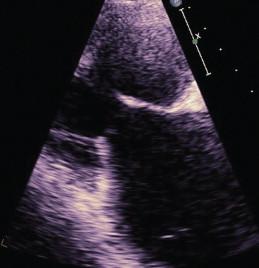Physical Address
304 North Cardinal St.
Dorchester Center, MA 02124
Carcinoid tumors are rare with an incidence of about 4 per 100,000 general population per year. They originate from enterochromaffin cells, which are localized in 70% of cases in the gastrointestinal system and more rarely in the bronchopulmonary system. Carcinoid tumors are characterized by excess secretion of serotonin and other vasoactive substances. The primary tumor is often asymptomatic until hepatic metastases take place, which then produce the carcinoid syndrome. This syndrome is characterized by cutaneous flushing, sweating, diarrhea, bronchoconstriction, and facial telangiectasia. Valvular manifestations occur almost always in patients with secondary hepatic metastases, which allow vasoactive amines to reach the right-sided valves without being metabolized by the liver. These vasoactive substances include 5-hydroxytyptamine, 5-hydroxytryptophan, histamine, bradykinins, tachykinins, and prostaglandins.
Carcinoid heart disease occurs following hepatic metastasis and involves primarily the right-sided valves displaying tricuspid regurgitation and/or stenosis ( Fig. 36-1 ) or pulmonary valve regurgitation and/or stenosis ( Fig. 36-2 ). The involvement of the left-sided valves occurs less frequently, with the mitral valve involved more commonly than the aortic valve ( Fig. 36-3 ). The left-sided valvular lesions occur in patients with patent foramen ovale , with carcinoid tumor of the lung, or with tumors having high levels of serotonin. Valvular lesions typically consist of leaflet thickening and retraction. Histological studies show fibrocellular plaques with hypercellularity and a collagenous matrix ( Fig. 36-4 ).
The carcinoid syndrome is present in most patients with carcinoid heart disease. Clinical signs of right-sided heart failure are also common findings because of the involvement of the tricuspid and/or pulmonary valves. Labile blood pressure is another characteristic feature, depending on the concentration of the vasoactive substances in the circulation.
Echocardiography shows a type IIIa dysfunction in the tricuspid and pulmonic positions ( Fig. 36-5 ). The leaflets are thickened and retracted and the chordae are fused and shortened, resulting in a combined valvular stenosis and regurgitation. Calcification is rarely observed in these patients.

The diagnosis is confirmed by elevation in the levels of biological products derived from serotonin metabolism, such as 5-hydroxyindoleacetic acid (5-HIAA). Urinary levels of 5-HIAA have been classically used as a reliable biological marker for the assessment of tumor activity. Furthermore, levels of other biological markers such as serotonin, chromogranin A, and atrial natriuretic factor are typically elevated in the blood.
Become a Clinical Tree membership for Full access and enjoy Unlimited articles
If you are a member. Log in here